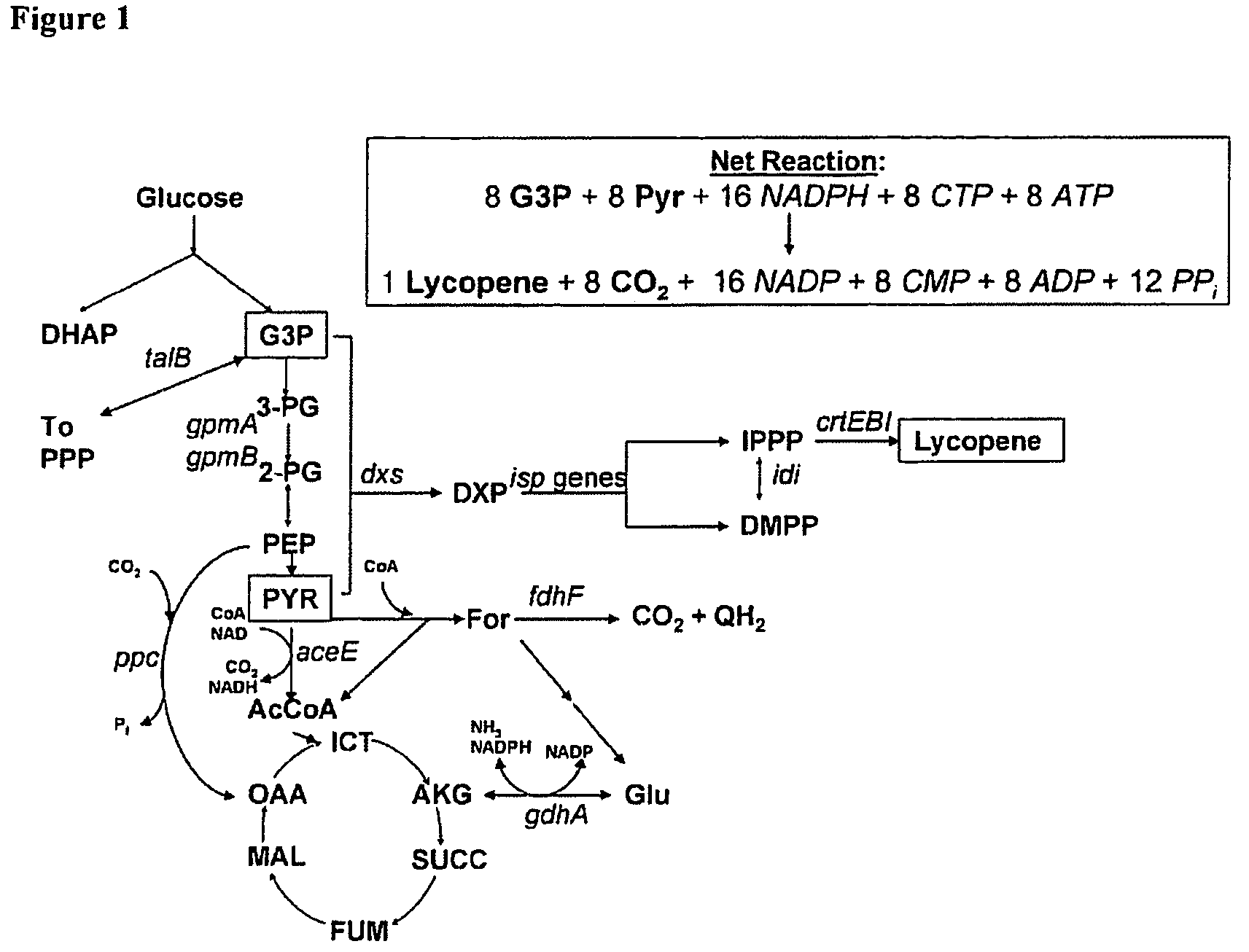Gene targets for enhanced carotenoid production
a technology of enhanced carotenoid and gene targets, which is applied in the direction of lyase, transferase, application, etc., can solve the problems of high cost of carotenoids, low carotenoid synthesis productivity in these plants, and difficult chemical production of compoundes, etc., and achieve the effect of enhancing carotenoid production
- Summary
- Abstract
- Description
- Claims
- Application Information
AI Technical Summary
Benefits of technology
Problems solved by technology
Method used
Image
Examples
example 1
Gene Target Identification for Lycopene Production in Single Gene Knockout Simulations
[0284]The E. coli iJE660a GSM model [Reed, J., et al. Genome Biology, 2003. 4(9): p. R54] served as the basis for the stoichiometrically balanced, genome-wide bioreaction network of E. coli metabolism, and the lycopene production pathway was utilized for identification of gene targets (FIG. 1). Additionally, the crtEBI operon was added to the model along with updated isoprenoid synthesis reaction details discovered after the formulation of this model (Table 3).
[0285]
TABLE 3Alterations of the iJE606a GSM- The following more comprehensiveisoprenoid biosynthesis pathway was created:PathwayGeneReactionIsoprenyl-pyrophosphatedxsT3P1 + PYR → DXP + CO2synthesis pathwayispCDXP + NADPH MEP + NADPispDMEP + CTP → CDPME + PPIispECDPME + ATP → CDPMEPP +ADPispFCDPMEPP → MECPP + CMPispGMECPP HMBPPispHHMBPP → 0.5 IPPP + 0.5 DMPPIsoprenyl pyrophosphateidiIPPP DMPPisomeraseFarnesyl pyrophosphateispA2IPPP → GPP...
example 2
Multiple Knockout Simulations
[0292]Optimization of a multigenic phenotype, such as lycopene production, depends on the modification of several genes. Hence, multiple gene knockouts need to be similarly evaluated. The difficulty lies in the exhaustive investigation of all possible gene knockout combinations necessary, which leads to combinatorial explosion: 965 C 2 combinations of all the possible double mutants, and so on Hence, sequential optimization approaches were invoked whereby single gene knockouts were investigated in the genetic background of deletion mutants identified for their improved phenotype from previous iterations. Such procedures emulate optimization routines of the type of steepest descent for non-linear optimization problems. However, while properties of continuity and convexity assure of a certain degree of success in the solution of mathematical problems, no such properties have been demonstrated for metabolic networks. Consequently, there can be no assurance ...
example 3
Experimental Investigation of Single and Multiple Gene Knockouts Confirmed FBA Predictions
[0296]Gene knockout experiments were conducted along with shaker-flask fermentations to experimentally test the predictions of the previous simulations. Knockout constructs were created using PCR product inactivation in a recombinant E. coli strain already engineered to produce lycopene at high yields through over-expressions of the dxs, ispFD, and idi genes (see Materials and Methods). This strain was heterologously expressing the crtEBI operon on a pAC-LYC plasmid encoding for the genes required to produce lycopene [Cunningham F X Jr, S. Z., Chamovitz D, Hirschberg J, Gantt E., Plant Cell, 1994. 6(8):1107-1121]FIG. 5 summarizes the results from nine knockout mutants constructed as described above and presents the lycopene production at the point of glucose exhaustion when strains were grown in an M9-minimal media with glucose as the sole carbon source. First, there is continuing improvement o...
PUM
| Property | Measurement | Unit |
|---|---|---|
| concentration | aaaaa | aaaaa |
| concentration | aaaaa | aaaaa |
| temperature | aaaaa | aaaaa |
Abstract
Description
Claims
Application Information
 Login to View More
Login to View More - R&D
- Intellectual Property
- Life Sciences
- Materials
- Tech Scout
- Unparalleled Data Quality
- Higher Quality Content
- 60% Fewer Hallucinations
Browse by: Latest US Patents, China's latest patents, Technical Efficacy Thesaurus, Application Domain, Technology Topic, Popular Technical Reports.
© 2025 PatSnap. All rights reserved.Legal|Privacy policy|Modern Slavery Act Transparency Statement|Sitemap|About US| Contact US: help@patsnap.com



